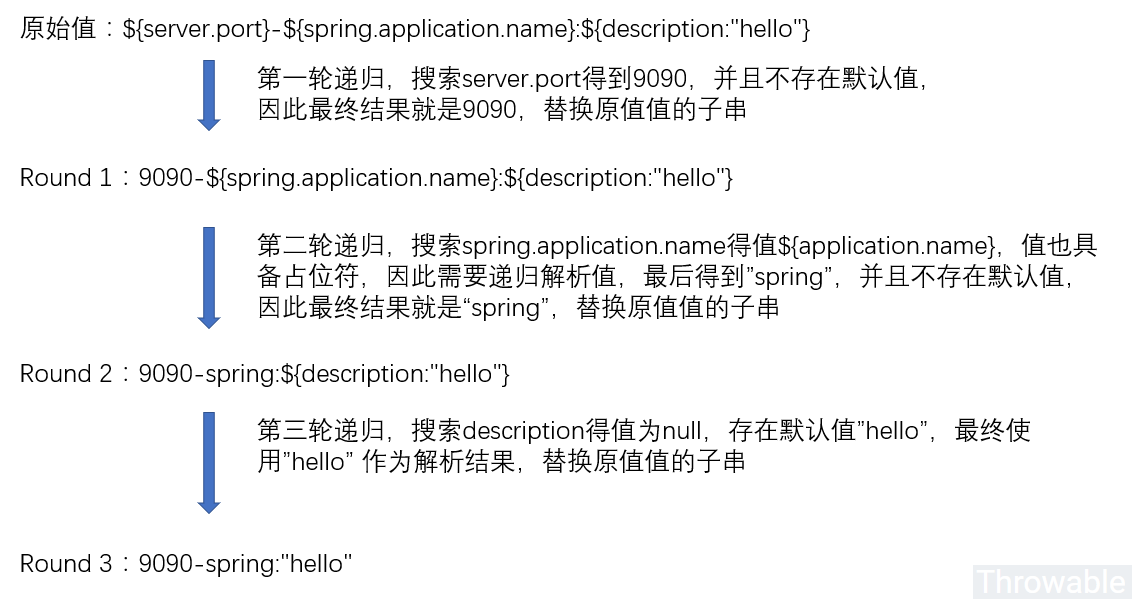жӮЁеҘҪпјҢзҷ»еҪ•еҗҺжүҚиғҪдёӢи®ўеҚ•е“ҰпјҒ
жӮЁеҘҪпјҢзҷ»еҪ•еҗҺжүҚиғҪдёӢи®ўеҚ•е“ҰпјҒ
еүҚжҸҗ
еүҚйқўеҶҷиҝҮдёҖзҜҮе…ідәҺEnvironmentеұһжҖ§еҠ иҪҪзҡ„жәҗз ҒеҲҶжһҗе’Ңжү©еұ•пјҢйҮҢйқўжҸҗеҲ°еұһжҖ§зҡ„еҚ дҪҚз¬Ұи§Јжһҗе’Ңзұ»еһӢиҪ¬жҚўжҳҜзӣёеҜ№еӨҚжқӮзҡ„пјҢиҝҷзҜҮж–Үз« е°ұжҳҜиҰҒеҲҶжһҗе’Ңи§ЈиҜ»иҝҷдёӨдёӘеӨҚжқӮзҡ„й—®йўҳгҖӮе…ідәҺиҝҷдёӨдёӘй—®йўҳпјҢйҖүз”ЁдёҖдёӘжҜ”иҫғеӨҚжқӮзҡ„еҸӮж•°еӨ„зҗҶж–№жі•PropertySourcesPropertyResolver#getPropertyпјҢи§ЈжһҗеҚ дҪҚз¬Ұзҡ„ж—¶еҖҷдҫқиө–еҲ°
PropertySourcesPropertyResolver#getPropertyAsRawStringпјҡ
protected String getPropertyAsRawString(String key) {
return getProperty(key, String.class, false);
}
protected <T> T getProperty(String key, Class<T> targetValueType, boolean resolveNestedPlaceholders) {
if (this.propertySources != null) {
for (PropertySource<?> propertySource : this.propertySources) {
if (logger.isTraceEnabled()) {
logger.trace("Searching for key '" + key + "' in PropertySource '" +
propertySource.getName() + "'");
}
Object value = propertySource.getProperty(key);
if (value != null) {
if (resolveNestedPlaceholders && value instanceof String) {
//и§ЈжһҗеёҰжңүеҚ дҪҚз¬Ұзҡ„еұһжҖ§
value = resolveNestedPlaceholders((String) value);
}
logKeyFound(key, propertySource, value);
//йңҖиҰҒж—¶иҪ¬жҚўеұһжҖ§зҡ„зұ»еһӢ
return convertValueIfNecessary(value, targetValueType);
}
}
}
if (logger.isDebugEnabled()) {
logger.debug("Could not find key '" + key + "' in any property source");
}
return null;
}
еұһжҖ§еҚ дҪҚз¬Ұи§Јжһҗ
еұһжҖ§еҚ дҪҚз¬Ұзҡ„и§Јжһҗж–№жі•жҳҜPropertySourcesPropertyResolverзҡ„зҲ¶зұ»AbstractPropertyResolver#resolveNestedPlaceholdersпјҡ
protected String resolveNestedPlaceholders(String value) {
return (this.ignoreUnresolvableNestedPlaceholders ?
resolvePlaceholders(value) : resolveRequiredPlaceholders(value));
}
ignoreUnresolvableNestedPlaceholdersеұһжҖ§й»ҳи®ӨдёәfalseпјҢеҸҜд»ҘйҖҡиҝҮAbstractEnvironment#setIgnoreUnresolvableNestedPlaceholders(boolean ignoreUnresolvableNestedPlaceholders)и®ҫзҪ®пјҢеҪ“жӯӨеұһжҖ§иў«и®ҫзҪ®дёәtrueпјҢи§ЈжһҗеұһжҖ§еҚ дҪҚз¬ҰеӨұиҙҘзҡ„ж—¶еҖҷ(并且没жңүдёәеҚ дҪҚз¬Ұй…ҚзҪ®й»ҳи®ӨеҖј)дёҚдјҡжҠӣеҮәејӮеёёпјҢиҝ”еӣһеұһжҖ§еҺҹж ·еӯ—з¬ҰдёІпјҢеҗҰеҲҷдјҡжҠӣеҮәIllegalArgumentExceptionгҖӮжҲ‘们иҝҷйҮҢеҸӘйңҖиҰҒеҲҶжһҗAbstractPropertyResolver#resolveRequiredPlaceholdersпјҡ
//AbstractPropertyResolverдёӯзҡ„еұһжҖ§пјҡ
//ignoreUnresolvableNestedPlaceholders=trueжғ…еҶөдёӢеҲӣе»әзҡ„PropertyPlaceholderHelperе®һдҫӢ
@Nullable
private PropertyPlaceholderHelper nonStrictHelper;
//ignoreUnresolvableNestedPlaceholders=falseжғ…еҶөдёӢеҲӣе»әзҡ„PropertyPlaceholderHelperе®һдҫӢ
@Nullable
private PropertyPlaceholderHelper strictHelper;
//жҳҜеҗҰеҝҪз•Ҙж— жі•еӨ„зҗҶзҡ„еұһжҖ§еҚ дҪҚз¬ҰпјҢиҝҷйҮҢжҳҜfalseпјҢд№ҹе°ұжҳҜйҒҮеҲ°ж— жі•еӨ„зҗҶзҡ„еұһжҖ§еҚ дҪҚз¬Ұдё”жІЎжңүй»ҳи®ӨеҖјеҲҷжҠӣеҮәејӮеёё
private boolean ignoreUnresolvableNestedPlaceholders = false;
//еұһжҖ§еҚ дҪҚз¬ҰеүҚзјҖпјҢиҝҷйҮҢжҳҜ"${"
private String placeholderPrefix = SystemPropertyUtils.PLACEHOLDER_PREFIX;
//еұһжҖ§еҚ дҪҚз¬ҰеҗҺзјҖпјҢиҝҷйҮҢжҳҜ"}"
private String placeholderSuffix = SystemPropertyUtils.PLACEHOLDER_SUFFIX;
//еұһжҖ§еҚ дҪҚз¬Ұи§ЈжһҗеӨұиҙҘзҡ„ж—¶еҖҷй…ҚзҪ®й»ҳи®ӨеҖјзҡ„еҲҶйҡ”з¬ҰпјҢиҝҷйҮҢжҳҜ":"
@Nullable
private String valueSeparator = SystemPropertyUtils.VALUE_SEPARATOR;
public String resolveRequiredPlaceholders(String text) throws IllegalArgumentException {
if (this.strictHelper == null) {
this.strictHelper = createPlaceholderHelper(false);
}
return doResolvePlaceholders(text, this.strictHelper);
}
//еҲӣе»әдёҖдёӘж–°зҡ„PropertyPlaceholderHelperе®һдҫӢпјҢиҝҷйҮҢignoreUnresolvablePlaceholdersдёәfalse
private PropertyPlaceholderHelper createPlaceholderHelper(boolean ignoreUnresolvablePlaceholders) {
return new PropertyPlaceholderHelper(this.placeholderPrefix, this.placeholderSuffix, this.valueSeparator, ignoreUnresolvablePlaceholders);
}
//иҝҷйҮҢжңҖз»Ҳзҡ„и§Јжһҗе·ҘдҪң委жүҳеҲ°PropertyPlaceholderHelper#replacePlaceholdersе®ҢжҲҗ
private String doResolvePlaceholders(String text, PropertyPlaceholderHelper helper) {
return helper.replacePlaceholders(text, this::getPropertyAsRawString);
}
жңҖз»ҲеҸӘйңҖиҰҒеҲҶжһҗPropertyPlaceholderHelper#replacePlaceholdersпјҢиҝҷйҮҢйңҖиҰҒйҮҚзӮ№жіЁж„Ҹпјҡ
жіЁж„ҸеҲ°иҝҷйҮҢзҡ„第дёҖдёӘеҸӮж•°textе°ұжҳҜеұһжҖ§еҖјзҡ„жәҗеӯ—з¬ҰдёІпјҢдҫӢеҰӮжҲ‘们йңҖиҰҒеӨ„зҗҶзҡ„еұһжҖ§дёәmyProperties: ${server.port}-${spring.application.name}пјҢиҝҷйҮҢзҡ„textе°ұжҳҜ${server.port}-${spring.application.name}гҖӮ
replacePlaceholdersж–№жі•зҡ„第дәҢдёӘеҸӮж•°placeholderResolverпјҢиҝҷйҮҢжҜ”иҫғе·§еҰҷпјҢиҝҷйҮҢзҡ„ж–№жі•еј•з”Ёthis::getPropertyAsRawStringзӣёеҪ“дәҺдёӢйқўзҡ„д»Јз Ғпјҡ
//PlaceholderResolverжҳҜдёҖдёӘеҮҪж•°ејҸжҺҘеҸЈ
@FunctionalInterface
public interface PlaceholderResolver {
@Nullable
String resolvePlaceholder(String placeholderName);
}
//this::getPropertyAsRawStringзӣёеҪ“дәҺдёӢйқўзҡ„д»Јз Ғ
return new PlaceholderResolver(){
@Override
String resolvePlaceholder(String placeholderName){
//иҝҷйҮҢи°ғз”ЁеҲ°зҡ„жҳҜPropertySourcesPropertyResolver#getPropertyAsRawStringпјҢжңүзӮ№з»•
return getPropertyAsRawString(placeholderName);
}
}
жҺҘзқҖзңӢPropertyPlaceholderHelper#replacePlaceholdersзҡ„жәҗз Ғпјҡ
//еҹәзЎҖеұһжҖ§
//еҚ дҪҚз¬ҰеүҚзјҖпјҢй»ҳи®ӨжҳҜ"${"
private final String placeholderPrefix;
//еҚ дҪҚз¬ҰеҗҺзјҖпјҢй»ҳи®ӨжҳҜ"}"
private final String placeholderSuffix;
//з®ҖеҚ•зҡ„еҚ дҪҚз¬ҰеүҚзјҖпјҢй»ҳи®ӨжҳҜ"{"пјҢдё»иҰҒз”ЁдәҺеӨ„зҗҶеөҢеҘ—зҡ„еҚ дҪҚз¬ҰеҰӮ${xxxxx.{yyyyy}}
private final String simplePrefix;
//й»ҳи®ӨеҖјеҲҶйҡ”з¬ҰеҸ·пјҢй»ҳи®ӨжҳҜ":"
@Nullable
private final String valueSeparator;
//жӣҝжҚўеұһжҖ§еҚ дҪҚз¬Ұ
public String replacePlaceholders(String value, PlaceholderResolver placeholderResolver) {
Assert.notNull(value, "'value' must not be null");
return parseStringValue(value, placeholderResolver, new HashSet<>());
}
//йҖ’еҪ’и§ЈжһҗеёҰеҚ дҪҚз¬Ұзҡ„еұһжҖ§дёәеӯ—з¬ҰдёІ
protected String parseStringValue(
String value, PlaceholderResolver placeholderResolver, Set<String> visitedPlaceholders) {
StringBuilder result = new StringBuilder(value);
int startIndex = value.indexOf(this.placeholderPrefix);
while (startIndex != -1) {
//жҗңзҙўз¬¬дёҖдёӘеҚ дҪҚз¬ҰеҗҺзјҖзҡ„зҙўеј•
int endIndex = findPlaceholderEndIndex(result, startIndex);
if (endIndex != -1) {
//жҸҗеҸ–第дёҖдёӘеҚ дҪҚз¬Ұдёӯзҡ„еҺҹе§Ӣеӯ—з¬ҰдёІпјҢеҰӮ${server.port}->server.port
String placeholder = result.substring(startIndex + this.placeholderPrefix.length(), endIndex);
String originalPlaceholder = placeholder;
//еҲӨйҮҚ
if (!visitedPlaceholders.add(originalPlaceholder)) {
throw new IllegalArgumentException(
"Circular placeholder reference '" + originalPlaceholder + "' in property definitions");
}
// Recursive invocation, parsing placeholders contained in the placeholder key.
// йҖ’еҪ’и°ғз”ЁпјҢе®һйҷ…дёҠе°ұжҳҜи§ЈжһҗеөҢеҘ—зҡ„еҚ дҪҚз¬ҰпјҢеӣ дёәжҸҗеҸ–зҡ„еҺҹе§Ӣеӯ—з¬ҰдёІжңүеҸҜиғҪиҝҳжңүдёҖеұӮжҲ–иҖ…еӨҡеұӮеҚ дҪҚз¬Ұ
placeholder = parseStringValue(placeholder, placeholderResolver, visitedPlaceholders);
// Now obtain the value for the fully resolved key...
// йҖ’еҪ’и°ғз”Ёе®ҢжҜ•еҗҺпјҢеҸҜд»ҘзЎ®е®ҡеҫ—еҲ°зҡ„еӯ—з¬ҰдёІдёҖе®ҡжҳҜдёҚеёҰеҚ дҪҚз¬ҰпјҢиҝҷдёӘж—¶еҖҷи°ғз”ЁgetPropertyAsRawStringиҺ·еҸ–keyеҜ№еә”зҡ„еӯ—з¬ҰдёІеҖј
String propVal = placeholderResolver.resolvePlaceholder(placeholder);
// еҰӮжһңеӯ—з¬ҰдёІеҖјдёәnullпјҢеҲҷиҝӣиЎҢй»ҳи®ӨеҖјзҡ„и§ЈжһҗпјҢеӣ дёәй»ҳи®ӨеҖјжңүеҸҜиғҪд№ҹдҪҝз”ЁдәҶеҚ дҪҚз¬ҰпјҢеҰӮ${server.port:${server.port-2:8080}}
if (propVal == null && this.valueSeparator != null) {
int separatorIndex = placeholder.indexOf(this.valueSeparator);
if (separatorIndex != -1) {
String actualPlaceholder = placeholder.substring(0, separatorIndex);
// жҸҗеҸ–й»ҳи®ӨеҖјзҡ„еӯ—з¬ҰдёІ
String defaultValue = placeholder.substring(separatorIndex + this.valueSeparator.length());
// иҝҷйҮҢжҳҜжҠҠй»ҳи®ӨеҖјзҡ„иЎЁиҫҫејҸеҒҡдёҖж¬Ўи§ЈжһҗпјҢи§ЈжһҗеҲ°nullпјҢеҲҷзӣҙжҺҘиөӢеҖјдёәdefaultValue
propVal = placeholderResolver.resolvePlaceholder(actualPlaceholder);
if (propVal == null) {
propVal = defaultValue;
}
}
}
// дёҠдёҖжӯҘи§ЈжһҗеҮәжқҘзҡ„еҖјдёҚдёәnullпјҢдҪҶжҳҜе®ғжңүеҸҜиғҪжҳҜдёҖдёӘеёҰеҚ дҪҚз¬Ұзҡ„еҖјпјҢжүҖд»ҘеҗҺйқўеҜ№еҖјиҝӣиЎҢйҖ’еҪ’и§Јжһҗ
if (propVal != null) {
// Recursive invocation, parsing placeholders contained in the
// previously resolved placeholder value.
propVal = parseStringValue(propVal, placeholderResolver, visitedPlaceholders);
// иҝҷдёҖжӯҘеҫҲйҮҚиҰҒпјҢжӣҝжҚўжҺү第дёҖдёӘиў«и§Јжһҗе®ҢжҜ•зҡ„еҚ дҪҚз¬ҰеұһжҖ§пјҢдҫӢеҰӮ${server.port}-${spring.application.name} -> 9090--${spring.application.name}
result.replace(startIndex, endIndex + this.placeholderSuffix.length(), propVal);
if (logger.isTraceEnabled()) {
logger.trace("Resolved placeholder '" + placeholder + "'");
}
// йҮҚзҪ®startIndexдёәдёӢдёҖдёӘйңҖиҰҒи§Јжһҗзҡ„еҚ дҪҚз¬ҰеүҚзјҖзҡ„зҙўеј•пјҢеҸҜиғҪдёә-1пјҢиҜҙжҳҺи§Јжһҗз»“жқҹ
startIndex = result.indexOf(this.placeholderPrefix, startIndex + propVal.length());
}
else if (this.ignoreUnresolvablePlaceholders) {
// еҰӮжһңpropValдёәnull并且ignoreUnresolvablePlaceholdersи®ҫзҪ®дёәtrueпјҢзӣҙжҺҘиҝ”еӣһеҪ“еүҚзҡ„еҚ дҪҚз¬Ұд№Ӣй—ҙзҡ„еҺҹе§Ӣеӯ—з¬ҰдёІе°ҫзҡ„зҙўеј•пјҢд№ҹе°ұжҳҜи·іиҝҮи§Јжһҗ
// Proceed with unprocessed value.
startIndex = result.indexOf(this.placeholderPrefix, endIndex + this.placeholderSuffix.length());
}
else {
// еҰӮжһңpropValдёәnull并且ignoreUnresolvablePlaceholdersи®ҫзҪ®дёәfalseпјҢжҠӣеҮәејӮеёё
throw new IllegalArgumentException("Could not resolve placeholder '" +
placeholder + "'" + " in value \"" + value + "\"");
}
// йҖ’еҪ’з»“жқҹ移йҷӨеҲӨйҮҚйӣҶеҗҲдёӯзҡ„е…ғзҙ
visitedPlaceholders.remove(originalPlaceholder);
}
else {
// endIndex = -1иҜҙжҳҺи§Јжһҗз»“жқҹ
startIndex = -1;
}
}
return result.toString();
}
//еҹәдәҺдј е…Ҙзҡ„иө·е§Ӣзҙўеј•пјҢжҗңзҙўз¬¬дёҖдёӘеҚ дҪҚз¬ҰеҗҺзјҖзҡ„зҙўеј•пјҢе…је®№еөҢеҘ—зҡ„еҚ дҪҚз¬Ұ
private int findPlaceholderEndIndex(CharSequence buf, int startIndex) {
//иҝҷйҮҢindexе®һйҷ…дёҠе°ұжҳҜе®һйҷ…йңҖиҰҒи§Јжһҗзҡ„еұһжҖ§зҡ„第дёҖдёӘеӯ—з¬ҰпјҢеҰӮ${server.port}пјҢиҝҷйҮҢindexжҢҮеҗ‘s
int index = startIndex + this.placeholderPrefix.length();
int withinNestedPlaceholder = 0;
while (index < buf.length()) {
//indexжҢҮеҗ‘"}"пјҢиҜҙжҳҺжңүеҸҜиғҪеҲ°иҫҫеҚ дҪҚз¬Ұе°ҫйғЁжҲ–иҖ…еөҢеҘ—еҚ дҪҚз¬Ұе°ҫйғЁ
if (StringUtils.substringMatch(buf, index, this.placeholderSuffix)) {
//еӯҳеңЁеөҢеҘ—еҚ дҪҚз¬ҰпјҢеҲҷиҝ”еӣһеӯ—з¬ҰдёІдёӯеҚ дҪҚз¬ҰеҗҺзјҖзҡ„зҙўеј•еҖј
if (withinNestedPlaceholder > 0) {
withinNestedPlaceholder--;
index = index + this.placeholderSuffix.length();
}
else {
//дёҚеӯҳеңЁеөҢеҘ—еҚ дҪҚз¬ҰпјҢзӣҙжҺҘиҝ”еӣһеҚ дҪҚз¬Ұе°ҫйғЁзҙўеј•
return index;
}
}
//indexжҢҮеҗ‘"{"пјҢи®°еҪ•еөҢеҘ—еҚ дҪҚз¬ҰдёӘж•°withinNestedPlaceholderеҠ 1пјҢindexжӣҙж–°дёәеөҢеҘ—еұһжҖ§зҡ„第дёҖдёӘеӯ—з¬Ұзҡ„зҙўеј•
else if (StringUtils.substringMatch(buf, index, this.simplePrefix)) {
withinNestedPlaceholder++;
index = index + this.simplePrefix.length();
}
else {
//indexдёҚжҳҜ"{"жҲ–иҖ…"}"пјҢеҲҷиҝӣиЎҢиҮӘеўһ
index++;
}
}
//иҝҷйҮҢиҜҙжҳҺи§Јжһҗзҙўеј•е·Із»Ҹи¶…еҮәдәҶеҺҹеӯ—з¬ҰдёІ
return -1;
}
//StringUtils#substringMatchпјҢжӯӨж–№жі•дјҡжЈҖжҹҘеҺҹе§Ӣеӯ—з¬ҰдёІstrзҡ„indexдҪҚзҪ®ејҖе§ӢжҳҜеҗҰе’Ңеӯҗеӯ—з¬ҰдёІsubstringе®Ңе…ЁеҢ№й…Қ
public static boolean substringMatch(CharSequence str, int index, CharSequence substring) {
if (index + substring.length() > str.length()) {
return false;
}
for (int i = 0; i < substring.length(); i++) {
if (str.charAt(index + i) != substring.charAt(i)) {
return false;
}
}
return true;
}
дёҠйқўзҡ„иҝҮзЁӢзӣёеҜ№жҜ”иҫғеӨҚжқӮпјҢеӣ дёәз”ЁеҲ°дәҶйҖ’еҪ’пјҢжҲ‘们дёҫдёӘе®һйҷ…зҡ„дҫӢеӯҗиҜҙжҳҺдёҖдёӢж•ҙдёӘи§ЈжһҗиҝҮзЁӢпјҢдҫӢеҰӮжҲ‘们дҪҝз”ЁдәҶеӣӣдёӘеұһжҖ§йЎ№пјҢжҲ‘们зҡ„зӣ®ж ҮжҳҜиҺ·еҸ–server.descзҡ„еҖјпјҡ
application.name=spring
server.port=9090
spring.application.name=${application.name}
server.desc=${server.port-${spring.application.name}}:${description:"hello"}

еұһжҖ§зұ»еһӢиҪ¬жҚў
еңЁдёҠдёҖжӯҘи§ЈжһҗеұһжҖ§еҚ дҪҚз¬Ұе®ҢжҜ•д№ӢеҗҺпјҢеҫ—еҲ°зҡ„жҳҜеұһжҖ§еӯ—з¬ҰдёІеҖјпјҢеҸҜд»ҘжҠҠеӯ—з¬ҰдёІиҪ¬жҚўдёәжҢҮе®ҡзҡ„зұ»еһӢпјҢжӯӨеҠҹиғҪз”ұAbstractPropertyResolver#convertValueIfNecessaryе®ҢжҲҗпјҡ
protected <T> T convertValueIfNecessary(Object value, @Nullable Class<T> targetType) {
if (targetType == null) {
return (T) value;
}
ConversionService conversionServiceToUse = this.conversionService;
if (conversionServiceToUse == null) {
// Avoid initialization of shared DefaultConversionService if
// no standard type conversion is needed in the first place...
// иҝҷйҮҢдёҖиҲ¬еҸӘжңүеӯ—з¬ҰдёІзұ»еһӢжүҚдјҡе‘Ҫдёӯ
if (ClassUtils.isAssignableValue(targetType, value)) {
return (T) value;
}
conversionServiceToUse = DefaultConversionService.getSharedInstance();
}
return conversionServiceToUse.convert(value, targetType);
}
е®һйҷ…дёҠиҪ¬жҚўзҡ„йҖ»иҫ‘жҳҜ委жүҳеҲ°DefaultConversionServiceзҡ„зҲ¶зұ»ж–№жі•GenericConversionService#convertпјҡ
public <T> T convert(@Nullable Object source, Class<T> targetType) {
Assert.notNull(targetType, "Target type to convert to cannot be null");
return (T) convert(source, TypeDescriptor.forObject(source), TypeDescriptor.valueOf(targetType));
}
public Object convert(@Nullable Object source, @Nullable TypeDescriptor sourceType, TypeDescriptor targetType) {
Assert.notNull(targetType, "Target type to convert to cannot be null");
if (sourceType == null) {
Assert.isTrue(source == null, "Source must be [null] if source type == [null]");
return handleResult(null, targetType, convertNullSource(null, targetType));
}
if (source != null && !sourceType.getObjectType().isInstance(source)) {
throw new IllegalArgumentException("Source to convert from must be an instance of [" +
sourceType + "]; instead it was a [" + source.getClass().getName() + "]");
}
// д»Һзј“еӯҳдёӯиҺ·еҸ–GenericConverterе®һдҫӢпјҢе…¶е®һиҝҷдёҖжӯҘзӣёеҜ№еӨҚжқӮпјҢеҢ№й…ҚдёӨдёӘзұ»еһӢзҡ„ж—¶еҖҷпјҢдјҡи§Јжһҗж•ҙдёӘзұ»зҡ„еұӮж¬ЎиҝӣиЎҢеҜ№жҜ”
GenericConverter converter = getConverter(sourceType, targetType);
if (converter != null) {
// е®һйҷ…дёҠе°ұжҳҜи°ғз”ЁиҪ¬жҚўж–№жі•
Object result = ConversionUtils.invokeConverter(converter, source, sourceType, targetType);
// ж–ӯиЁҖжңҖз»Ҳз»“жһңе’ҢжҢҮе®ҡзұ»еһӢжҳҜеҗҰеҢ№й…Қ并且иҝ”еӣһ
return handleResult(sourceType, targetType, result);
}
return handleConverterNotFound(source, sourceType, targetType);
}
дёҠйқўжүҖжңүзҡ„еҸҜз”Ёзҡ„GenericConverterзҡ„е®һдҫӢеҸҜд»ҘеңЁDefaultConversionServiceзҡ„addDefaultConvertersдёӯзңӢеҲ°пјҢй»ҳи®Өж·»еҠ зҡ„иҪ¬жҚўеҷЁе®һдҫӢе·Із»Ҹи¶…иҝҮ20дёӘпјҢжңүдәӣжғ…еҶөдёӢеҰӮжһңж— жі•ж»Ўи¶ійңҖжұӮеҸҜд»Ҙж·»еҠ иҮӘе®ҡд№үзҡ„иҪ¬жҚўеҷЁпјҢе®һзҺ°GenericConverterжҺҘеҸЈж·»еҠ иҝӣеҺ»еҚіеҸҜгҖӮ
е°Ҹз»“
SpringBootеңЁжҠҪиұЎж•ҙдёӘзұ»еһӢиҪ¬жҚўеҷЁж–№йқўеҒҡзҡ„жҜ”иҫғеҘҪпјҢеңЁSpringMVCеә”з”ЁдёӯпјҢйҮҮз”Ёзҡ„жҳҜorg.springframework.boot.autoconfigure.web.format.WebConversionServiceпјҢе…је®№дәҶConverterгҖҒFormatterгҖҒConversionServiceзӯүиҪ¬жҚўеҷЁзұ»еһӢ并且еҜ№еӨ–жҸҗдҫӣдёҖеҘ—з»ҹдёҖзҡ„иҪ¬жҚўж–№жі•гҖӮ
жҖ»з»“
д»ҘдёҠе°ұжҳҜиҝҷзҜҮж–Үз« зҡ„е…ЁйғЁеҶ…е®№дәҶпјҢеёҢжңӣжң¬ж–Үзҡ„еҶ…е®№еҜ№еӨ§е®¶зҡ„еӯҰд№ жҲ–иҖ…е·ҘдҪңе…·жңүдёҖе®ҡзҡ„еҸӮиҖғеӯҰд№ д»·еҖјпјҢеҰӮжһңжңүз–‘й—®еӨ§е®¶еҸҜд»Ҙз•ҷиЁҖдәӨжөҒпјҢи°ўи°ўеӨ§е®¶еҜ№дәҝйҖҹдә‘зҡ„ж”ҜжҢҒгҖӮ
е…ҚиҙЈеЈ°жҳҺпјҡжң¬з«ҷеҸ‘еёғзҡ„еҶ…е®№пјҲеӣҫзүҮгҖҒи§Ҷйў‘е’Ңж–Үеӯ—пјүд»ҘеҺҹеҲӣгҖҒиҪ¬иҪҪе’ҢеҲҶдә«дёәдё»пјҢж–Үз« и§ӮзӮ№дёҚд»ЈиЎЁжң¬зҪ‘з«ҷз«ӢеңәпјҢеҰӮжһңж¶үеҸҠдҫөжқғиҜ·иҒ”зі»з«ҷй•ҝйӮ®з®ұпјҡis@yisu.comиҝӣиЎҢдёҫжҠҘпјҢ并жҸҗдҫӣзӣёе…іиҜҒжҚ®пјҢдёҖз»ҸжҹҘе®һпјҢе°Ҷз«ӢеҲ»еҲ йҷӨж¶үе«ҢдҫөжқғеҶ…е®№гҖӮ